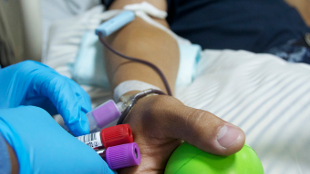One day, doctors may be able to use the metabolites in blood samples to predict the likelihood of a person surviving another five to 10 years, according to a newly developed tool described today (August 20) in Nature Communications. The authors of the report say the information may be useful in helping decide whether or not to do surgery on patients who are frail or could serve as endpoints in new clinical trials.
The study “shows the potential usefulness of metabolomic biomarkers,” says Paola Sebastiani, a biostatistician at Boston University who was not involved in the study. She adds that the field will need longitudinal studies in the future to assess the biomarkers’ clinical usefulness.
The team’s goal was to find blood-based biomarkers that can “indicate risk of vulnerability, especially if that information provides opportunities for an improvement in lifestyle or better treatment,” says Eline Slagboom, a molecular epidemiologist at Leiden University and the senior author on the study.
Doctors often use functionality measures such as grip strength and gait to determine an elderly patient’s health status, but these measures are imprecise. Other traditional biomarkers don’t necessarily apply to patients who hit a certain age. “For example, a somewhat higher weight, blood pressure, or cholesterol level is not as bad for individuals over 80 years of age as compared to younger individuals,” says Slagboom. So her group undertook the largest study of its kind to detect blood-based biomarkers of metabolism. “We have worked with biobanks from all over the world for three years to come to these results.”
The team used data from 12 cohorts of individuals of European descent, a total of 44,168 people aged 18–109, to identify 14 metabolites that they could use to develop a “score” to evaluate a person’s risk for mortality at five and 10 years out. During the study’s follow up, which ranged from around three years to nearly 17, depending on the cohort, 5,512 of the participants died.
Most of the biomarkers, which are involved in a variety of physiological processes such fatty acid metabolism, fluid balance, and inflammation, have previously been associated with mortality on their own, but never combined to form a single predictive score. And what’s more is, unlike traditional measures of weight and cholesterol, the biomarkers consistently predicted mortality in all participants rather than only among the younger ones.
A single point added to the score was associated with a 2.73-fold increased risk of mortality during the course of the study. In one of the cohorts of 7,603 individuals (including 1,213 who died), the team compared the accuracy of the metabolic score and of traditional biomarkers in predicting mortality. The metabolic score was about 83 percent accurate, whereas the traditional scores were about 78 percent accurate.
“We were surprised that the association of our biomarker score with mortality was so strong, given that it is only based on 14 metabolic markers in blood measured at a single point in the life of individuals,” says the study’s lead author, Joris Deelen, a researcher at the Max Planck Institute for the Biology of Ageing and the lead author of the study.
Despite the study’s impressive size, the authors caution that the information can’t yet be used to estimate an individual person’s risk of mortality. And outside experts also warned about over-interpreting the study’s results.
The study “proposes a hypothesis,” says Leo Cheng, a pathologist at Massachusetts General Hospital, but it doesn’t “prove anything.” That will require an independent cohort of participants. However, he adds that using a score that combines the information from all 14 biomarkers is “the correct thing [to do]” to provide a holistic look at metabolic pathways that may represent a person’s health.
The scientists used nuclear magnetic resonance (NMR) to analyze the samples because it is inexpensive and allowed them to process a large number of samples, but this strategy can lead to less reliable results than newer techniques for detecting metabolites, such as mass spectrometry.
Slagboom and her team are beginning to test the validity of the biomarker score in a range of existing studies to determine when the measurement might be most useful. For example, she says, she wonders if it could be used for elderly patients who enter the hospital with hip fractures or if the score could be useful to determine if a novel medication improves the risk of mortality in older patients. But Cheng warns that the people most interested in the ability to predict the likelihood of five and 10 year mortality may not be healthcare providers and patients, but instead, their insurers.







